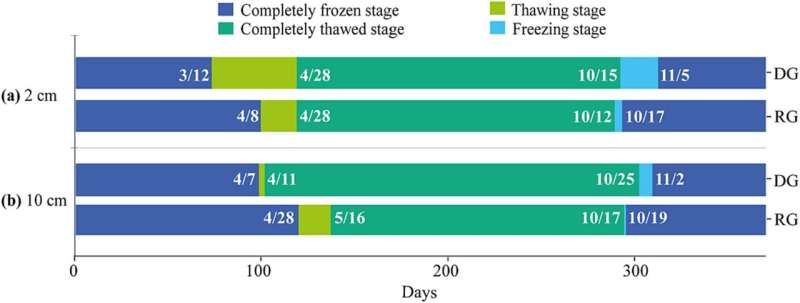This article has been reviewed according to Science X's editorial process and policies. Editors have highlighted the following attributes while ensuring the content's credibility:
fact-checked
trusted source
proofread
Revegetation in extremely degraded grassland improves permafrost stability on Qinghai-Tibetan plateau

As the dominant vegetation type in the permafrost regions of the Qinghai-Tibet Plateau (QTP), alpine grassland provides important ecosystem service functions, such as permafrost conservation. Over the last few decades, about 90% of alpine grassland has already suffered obvious degradation due to climate warming and overgrazing, which led to extensive permafrost degradation.
Revegetation by seeding natural grasses based on ecological restoration is currently an effective and widely used approach for restoring extremely degraded grassland on the QTP.
A research team led by Prof. Chen Shengyun from the Northwest Institute of Eco-Environmental and Resources of the Chinese Academy of Sciences compared and analyzed active layer thickness, soil freeze-thaw processes, and aggregate properties of extremely degraded grassland and revegetated grassland in the permafrost regions of the Shule River headwaters on the northeastern margin of the QTP in 2017–2020.
Their findings were published in Geoderma on Jan. 24.
The researchers found that the onset of completely frozen stage was advanced by 17 days, and the onset of completely thawed stage was delayed by 18 days in the 0–10 layer; the completely frozen duration was significantly increased by 47 days, while the freeze-thaw days was significantly decreased and freeze-thaw strength was weakened at 2cm depth. Active layer thickness was significantly reduced. The mean weight diameter was obviously increased and soil erodibility factor was significantly decreased in the 0–20 cm layer.
"These results indicate that the approach of revegetation in extremely degraded grassland can significantly improve permafrost stability," said Prof. Chen.
This study provides data support and scientific demonstration for development of permafrost conservation for extremely degraded grassland on the QTP, which in turn can realize the stabilization and enhancement of service functions of alpine grassland ecosystems under climate warming.
More information: Yinglan Jia et al, Improved permafrost stability by revegetation in extremely degraded grassland of the Qinghai-Tibetan Plateau, Geoderma (2023). DOI: 10.1016/j.geoderma.2023.116350
Provided by Chinese Academy of Sciences





















